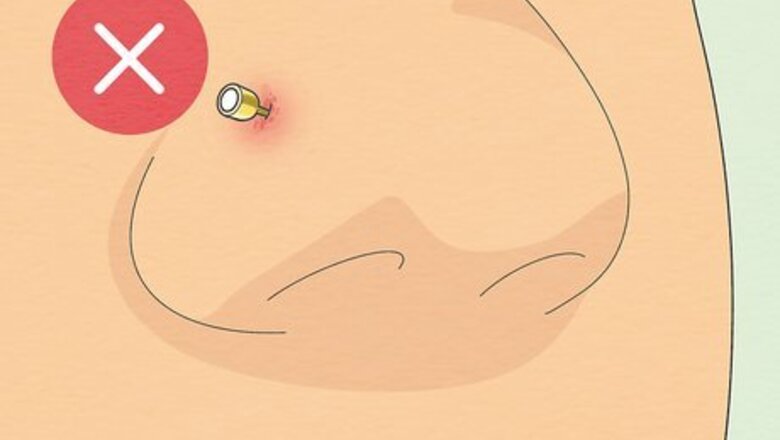
views
- Nose piercings are healed when they’re no longer red, swollen, painful to the touch, or leaking discharge.
- Nostril piercings heal in about 3–6 months, while bridge and septum piercings take about 2–4 months. Nasallang and rhino piercings may take a full year to heal.
- Clean your piercing twice a day with saline solution, avoid touching it when you can, and use a clean T-shirt as a pillowcase to speed up your healing time.
Signs of a Healed Piercing
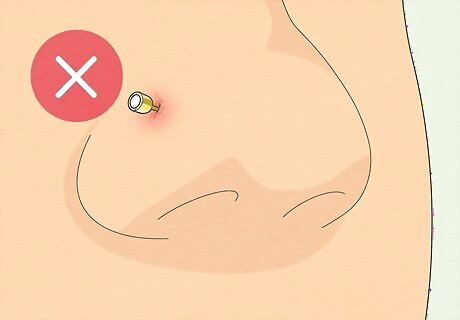
The skin around the piercing is no longer red or flakey. It’s normal for the skin to turn a little red or start peeling as you care for your new piercing. When the area around the piercing looks smooth and has the same flesh tone as the rest of your face, it’s a good sign that the skin has healed up.
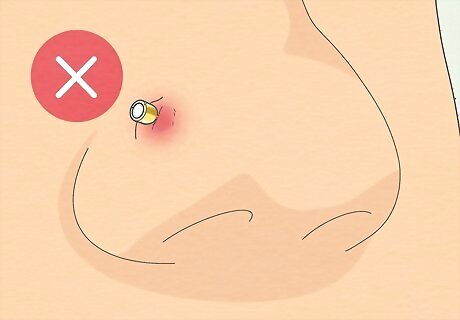
There isn’t swelling around the piercing site. Expect a little bit of swelling or a small bump near your piercing as your skin tries to repair itself and close any open wounds. As your skin continues to heal, your swelling will continue to subside and eventually disappear completely. Taking anti-inflammatory medicine may also reduce your swelling, so be sure to wait until the medication wears off to confirm if your piercing looks healed or not.
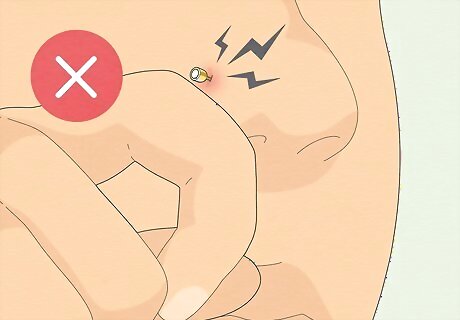
You don’t feel pain from touching or bumping your piercing. When the skin inside your piercing hasn’t fully healed yet, the slightest bump or movement could sting or make you sore. If you’re able to lightly touch your piercing without feeling any pain or sensitivity, then it means your skin has fully recovered. Moving your nose piercing around a lot may cause more irritation. Be gentle when you feel around the area so you don’t prolong your healing time.
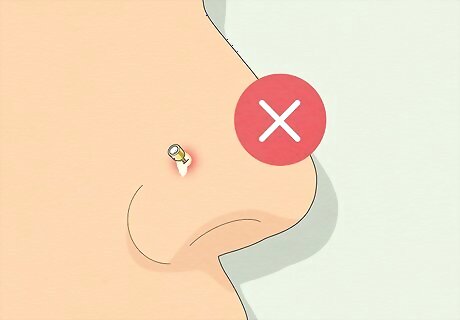
Your piercing has stopped leaking discharge. Clear discharge may come out of your piercing when you’re first healing as your body gets used to the new jewelry, and it may crust up from time to time. If you don’t notice any discharge building up around either side of the piercing, then it’s a good sign that you’ve completely healed.
How long does it take a nose piercing to heal?
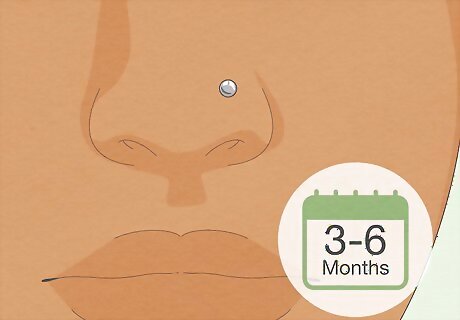
Nostril: 3–6 months Nostril piercings take a little while longer to heal compared to other piercings since soft cartilage takes longer to recover. When you pierce your nose, it may look healed from the outside within a month or two. However, the wound may still be open inside your piercing and need a bit longer to fully recover. Accidentally bumping or moving your piercing around will prolong your healing time since it could re-open wounds. Nose studs tend to heal faster than nose rings since rings are more likely to get bumped or moved around. If you used a piercing gun for your nose, it will take an extra month or two to heal than if you had your piercing done with a needle since a gun causes more skin trauma.
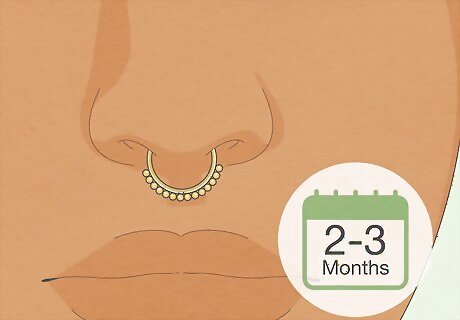
Septum: 2–3 months Septum piercings go through the skin that’s between your nostrils. Since you’re not going through any of the tough cartilage, you’ll usually have a shorter healing time when you get a septum piercing.
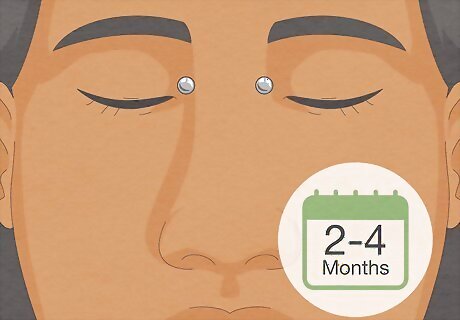
Bridge: 2–4 months Bridge piercings go through the skin at the top of your nose between your eyes. Because you’re only piercing through a small section of tissue and no cartilage, it will only take a couple of months to heal with the proper care. If your piercing is made of a thicker gauge, it may take slightly longer to heal than if you had a thinner gauge.
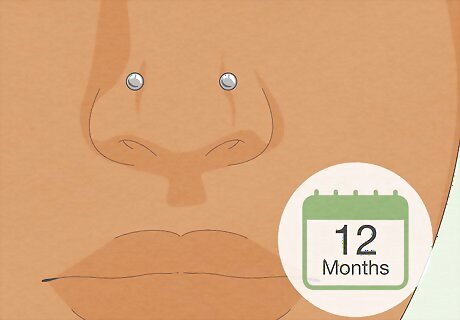
Nasallang: 12 months A nasallang, or tri-nasal piercing, goes through both nostrils and your septum, so 3 separate holes need to heal. Since 2 of the piercings go through cartilage and they all need to heal, give it at least a full year for your skin to recover.
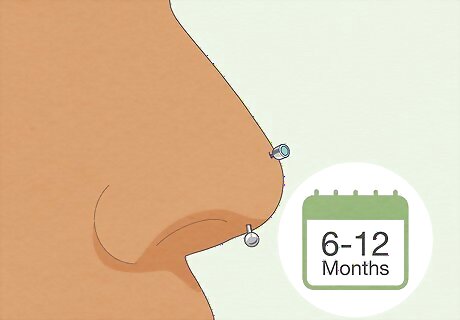
Rhino: 6–12 months A rhino, or vertical nose tip, is a less common piercing that goes vertically through the tip of your nose. Since the skin at the tip of your nose is thicker than any other part of your nose, these piercings heal more slowly compared to others.
How to Heal a Nose Piercing
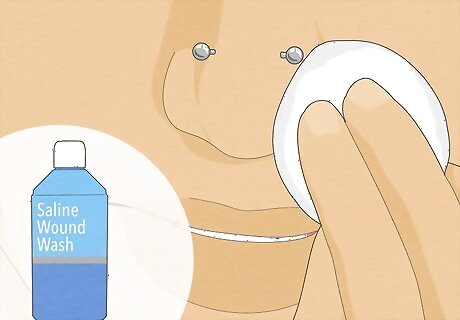
Clean your piercing with sterile saline solution twice daily. Start by washing your hands so they don’t have any bacteria on them. Heat the saline solution in your microwave until it’s just warm and dip a piece of gauze in the liquid. Hold the damp gauze against both sides of your piercing and gently clean your piercing by wiping away any crusty discharge on your jewelry. When you’re finished, pat your piercing dry with a paper towel. Avoid using antiseptic products like hydrogen peroxide or rubbing alcohol since they can prolong your healing time. If you want to make your own saline solution, mix in ¼ teaspoon (1.5 grams) of sea salt with 1 ⁄2 fluid ounces (44 ml) of warm distilled water.
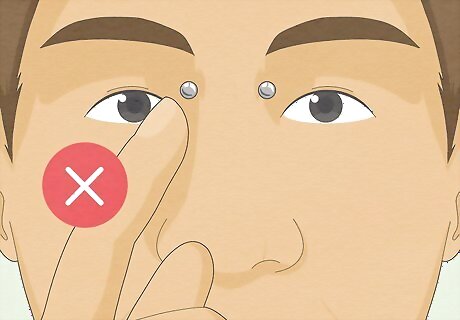
Touch your piercing as little as possible. Any time you touch, bump, or rub something against your nose piercing, it causes more irritation that prolongs your healing time. Your hands may also have bacteria that could get into your open piercing and cause an infection, so it’s best to leave your piercing alone. Wash your hands with antibacterial soap before you touch your piercing so you’re less likely to spread infection. Be especially careful when you’re putting on clothes or drying off after a shower so the fabric doesn’t snag on your jewelry and cause more irritation.
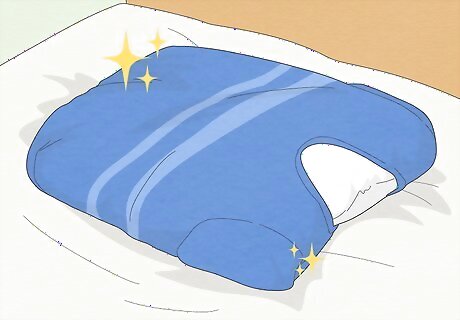
Use a clean T-shirt as a pillowcase throughout the healing process. Your pillowcase can gather bacteria while you sleep, so avoid using it right after you get your piercing. Instead, slip a soft, old T-shirt over your pillow. After your first night of sleep, flip your pillow over so you have a clean surface. Then on the following night, turn the shirt inside-out and put it back on your pillow. T-shirts are better than pillowcases since you can get 4 nights of sleep with clean fabric compared to 2 with a pillowcase.
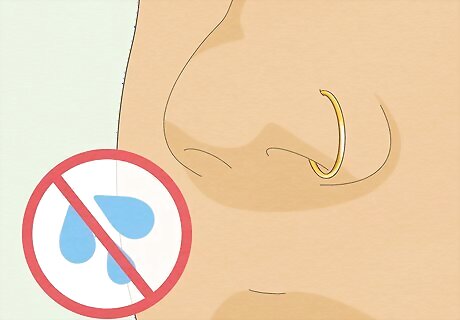
Avoid swimming with your piercing for 6 weeks. Submerging your new piercings completely makes it easier for bacteria to get inside and cause infections. Avoid taking baths, going to the pool, sitting in a jacuzzi, or taking a dip in any natural body of water until your piercings are fully healed. It’s still okay to shower or soak your piercing in a sterile saline solution.
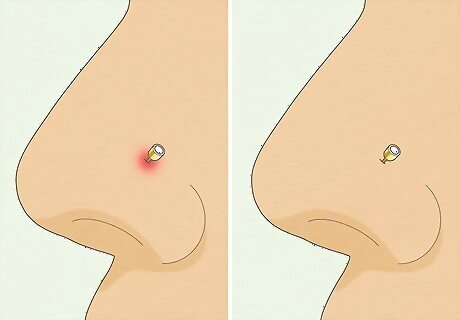
Wait until your piercing is fully healed before putting in new jewelry. Even if you’re really excited to change your piercing to a different piece of jewelry, let your piercing heal completely before taking it out. If you try changing your piercing too soon, you may reopen wounds and leave scars on your skin. If your piercing still shows signs of irritation, redness, or swelling, wait longer to change your jewelry to avoid getting an infection.
Signs of an Infected Piercing
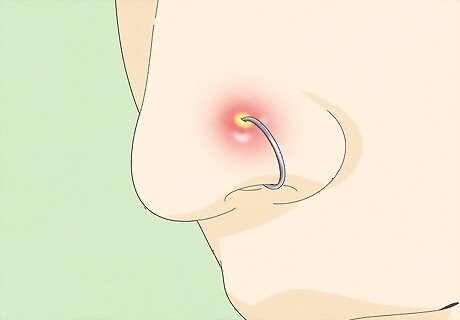
Increased redness or swelling While it’s normal for your piercing to have a little redness or swelling, bacteria may have gotten into your piercing if you have sudden or excessive skin trauma. Keep an eye on your piercing for any changes in color or size so it’s easy to tell when there’s a drastic change. Your skin will also feel a little more sensitive or painful when you touch it. Try taking an anti-inflammatory medication to see if the redness and swelling go down. Soak your piercing in a sterile saline solution for 20 minutes 3–4 times a day to help curb the infection. Alternatively, apply a gauze compress soaked in saline solution instead.
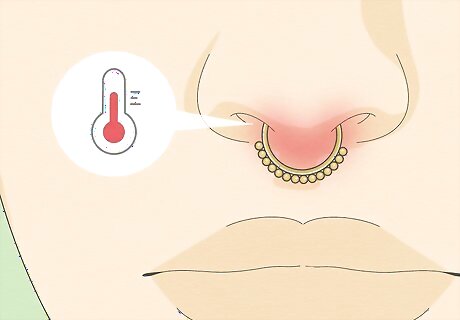
Hot or warm skin around your piercing Wash your hands and hold them close to your piercings to see if your skin is radiating heat. Since your body will warm up to try and kill bacteria, it’s usually a good sign that your skin is infected. Try applying an antibacterial ointment around your piercing to help kill off any germs causing the infection.
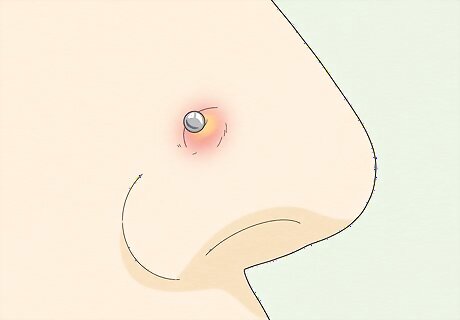
Large bumps near your piercing Small bumps or areas of inflammation are pretty standard on most nose piercings, but a large, hard bump may be a sign of bacteria. When you notice a bump, check if it feels hot or painful to the touch. Make sure you continue to clean around your piercing twice a day and avoid touching the bumps so they go down. If the bumps don’t go away on their own, then you may have keloids, which are hardened scar tissue that form as your piercing heals. Talk to a doctor about options for getting rid of keloids, such as corticosteroid injections, cryotherapy, or surgery.

Pus or blood around the piercing Clear discharge is normal for a new piercing, but green, yellow, or brown pus oozing from the opening means bacteria have gotten inside. Alternatively, if you notice blood, it may mean your piercing isn’t healing properly and needs medical attention. Avoid picking at your piercing since you could open the wounds. Just keep the area clean and sterilized so your infection doesn’t worsen.

















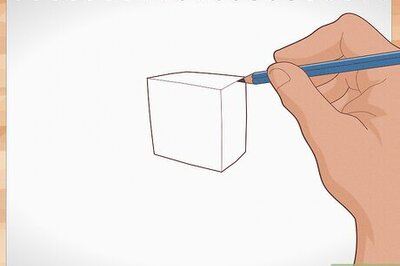
Comments
0 comment